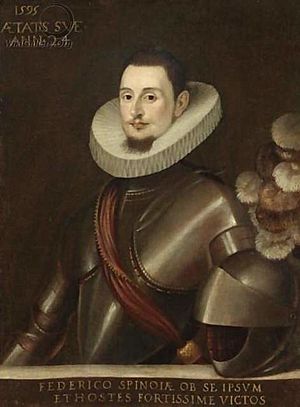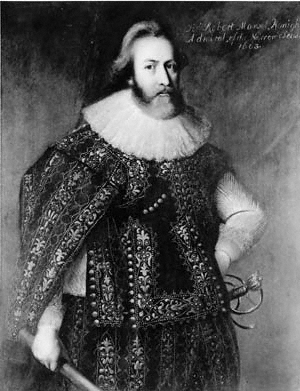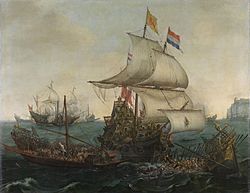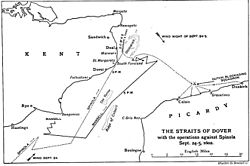Battle of the Narrow Seas facts for kids
Quick facts for kids Battle of the Narrow Seas |
|||||||
|---|---|---|---|---|---|---|---|
| Part of the Anglo-Spanish War (1585) & the Eighty Years' War | |||||||
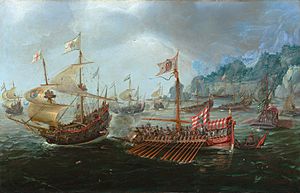 The battle in the strait between Calais and Dover on 3 and 4 October 1602 between the Spanish galleys of Federico Spinola and Dutch and English warships Painting by Andries van Eertvelt |
|||||||
|
|||||||
| Belligerents | |||||||
| Commanders and leaders | |||||||
| Strength | |||||||
|
6 galleys
|
9 galleons, carracks, & galiots | ||||||
| Casualties and losses | |||||||
| 2 galleys sunk, 1 galley interned (burnt) 2,000 killed, wounded, or captured |
Light | ||||||
The Battle of the Narrow Seas, also known as the Battle of the Goodwin Sands or Battle of the Dover Straits, was a big naval fight. It happened on October 3-4, 1602. This battle was part of the Anglo-Spanish War and the Eighty Years' War (also called the Dutch Revolt).
An English fleet, led by Sir Robert Mansell, found and attacked six Spanish galley ships. These Spanish ships were commanded by Federico Spinola in the Strait of Dover. The battle started near England's coast and ended near the Spanish Netherlands. Soon, a Dutch fleet, led by Jan Adriaanszoon Cant, joined the English. Together, they defeated the Spanish ships.
Contents
Why the Battle Happened
In 1602, a Spanish soldier named Federico Spinola had done very well in the Army of Flanders. He had even sailed through the English Channel in 1599 without any trouble. This made people in England very worried, fearing a larger Spanish invasion.
Spinola was excited by his success. He convinced Philip III of Spain and other leaders that a huge invasion of England could happen using galleys from Flanders. However, the plan was scaled down to just eight galleys, which Spinola paid for himself.
On his way to Flanders, Spinola's fleet was attacked by Sir Richard Leveson at Sesimbra Bay. Spinola lost two of his galleys there.
Spinola's Journey to Flanders
After this defeat, Spinola took his remaining six galleys back to Lisbon. He loaded them with money to pay his troops in Flanders. On the way to Flanders, he captured an English merchant ship.
At Santander, Spain, he picked up 400 more soldiers. This brought his total troops to 1,600 men. News spread in England that Spinola was trying to sail through the English Channel again. His goal was to reach Sluis, a port in Flanders.
Robert Cecil, an English leader, knew about Spinola's approach. Queen Elizabeth decided to act. She ordered Sir Robert Mansell to join a Dutch fleet near Dunkirk and Sluis. Their mission was to stop Spinola.
Meanwhile, the Dutch government had sent nine ships to stop Spinola. But when they got near Spain, Spinola had already left for the north. The Dutch commander, Jacob van Duyvenvoorde, was sick with smallpox. He sent four of his ships back north under Jan Adriaanszoon Cant.
The Fight Begins
Mansell sailed with three English ships: the Hope (30 guns), the Victory (42 guns), and the Answer. They patrolled near Dungeness. Mansell's captain thought Spinola would try to sail very close to the English coast.
Mansell placed his ships a good distance apart. They used small, fast ships called flyboats to communicate with each other. They also communicated with the Dutch fleet near the Flemish coast, led by Jan Cant. On October 3, two Dutch flyboats, the Samson and the Moon, joined Mansell. Spinola was sailing right into a trap.
English Ships Attack
Just before midnight on October 3, Mansell spotted Spinola's galleys in the moonlight. Mansell ordered an attack. The Moon, Samson, and Answer charged at the galleys near Dungeness.
Spinola saw them and turned his galleys towards the southeast, aiming for the Flanders coast. But as he did, his lead ship, the San Felipe, crashed into the Victory and Hope. This forced the Spanish galleys further east by accident.
Accounts differ on what happened next. The English said the San Felipe was badly damaged by Victory's cannons. They claimed it only escaped when other galleys came to help. The Spanish, however, said their galleys rowed at full speed and passed between the English ships with little harm.
Mansell wanted to cause as much damage as possible. He told his gunners to fire at any ship they saw in the moonlight. He believed most of the galleys were hit. Many galley slaves jumped into the sea from the damaged ships. A few even reached shore and were captured at Dover Castle.
By the time both fleets reached Goodwin Sands, the Spanish galleys began to retreat towards the Flemish coast. A strong wind was blowing from the west, which helped the English ships chase them. The sound of gunfire signaled the Dutch to join the fight.
Dutch Join the Battle
The battle continued across the Narrow Seas towards Dunkirk, Nieuwpoort, Gravelines, and Sluis. The Dutch Admiral Jan Cant quickly blocked the Spanish ships. The English waited outside the Flemish ports in case any Spanish ships tried to escape.
The Dutch ship Makreel spotted the already damaged San Felipe. It fired a powerful broadside. The San Felipe tried to get away but found itself close to Vice-Admiral Cant's ship, the Halve Maene. The galley tried to hide in the dark by staying still, but this was a bad idea.
The Halve Maene sailed straight into the San Felipe, hitting it in the middle. This broke off the galley's mainmast and poop. As the Halve Maene pulled away, it fired a huge volley of cannon fire into the galley. Another Dutch ship then came to finish the job. The San Felipe sank quickly, taking everyone on board with it.
The Lucera tried the same trick of hiding. But a Dutch galiot (a small, fast ship) rammed her at full sail. The galley was hit between its mainmast and stern. The Dutch ship lost its own bowsprit, but it completely destroyed the back of the galley. Vice-Admiral Cant's Halve Maene then came back and finished off the Lucera by ramming it again, tearing the galley apart.
Meanwhile, the English Victory and two Dutch galiots chased two other galleys, the San Juan and Jacinto. These ships were already sinking. With nowhere to go and the strong wind against them, their commanders had to run them aground near Nieuwpoort. Both galleys managed to reach the safety of that port. Another galley escaped the Dutch and English for a while but ended up wrecked on the French coast near Calais.
The galley San Luis, which carried Spinola himself and 36 chests of money, tried to reach Dunkirk. But the tide was low, so it had to wait behind a sandbank. Ten Dutch ships attacked the San Luis, but Spinola managed to sail between them and reach Dunkirk. With this, the battle ended. The Dutch then formed a blockade to stop Spinola from escaping.
What Happened After
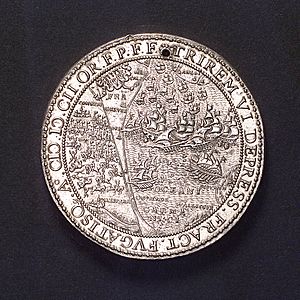
The Spanish suffered very heavy losses. Two galleys sank with everyone on board. About 2,000 Spanish soldiers, sailors, and galley slaves were killed, wounded, or captured. The wrecked galley at Calais was cut up for firewood by the French. Its Spanish crew were held, and the galley slaves were set free.
The Dutch and English had very few casualties. Some ships had no losses at all. Two Dutch ships were damaged from ramming, but the rest had only minor damage. The English ships had no damage, except for a broken mast on the Samson due to the strong wind.
This battle clearly showed how different galleons (the English and Dutch ships) were from galleys (the Spanish ships). It proved that Mediterranean-style galleys were not very useful in the northern waters. This change in warfare, along with cheaper iron cannons, meant the end for war galleys as important military ships.
Mansell was rewarded for his victory. He was named Vice-Admiral of the Narrow Seas. Van Duyvenvoorde and Cant both received special golden chains from the Dutch government.
Spinola managed to save half of his galleys. The two ships that reached Nieuwpoort soon joined the San Luis in Dunkirk. From there, these three ships sailed safely to Sluis. Spinola and his five galleys still posed a threat to English and Dutch shipping.
However, both the English and Dutch slowly gained control of the seas. This was true not just in the English Channel but across all European waters. Spinola was defeated again and fatally wounded at the Battle of Sluis by the Dutch forces trying to escape. Spinola's death and the later surrender of Sluis to the Dutch in 1604 ended his and Philip III's dreams of invading England with galleys from Flanders.
See also


